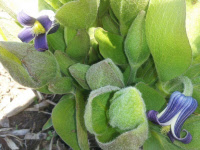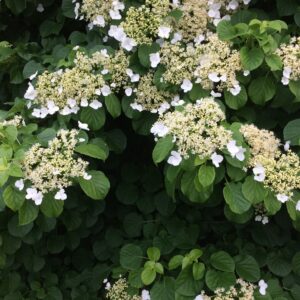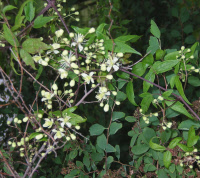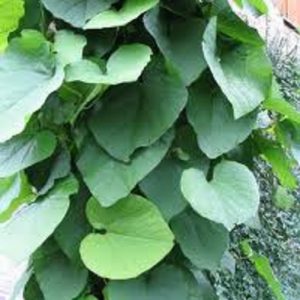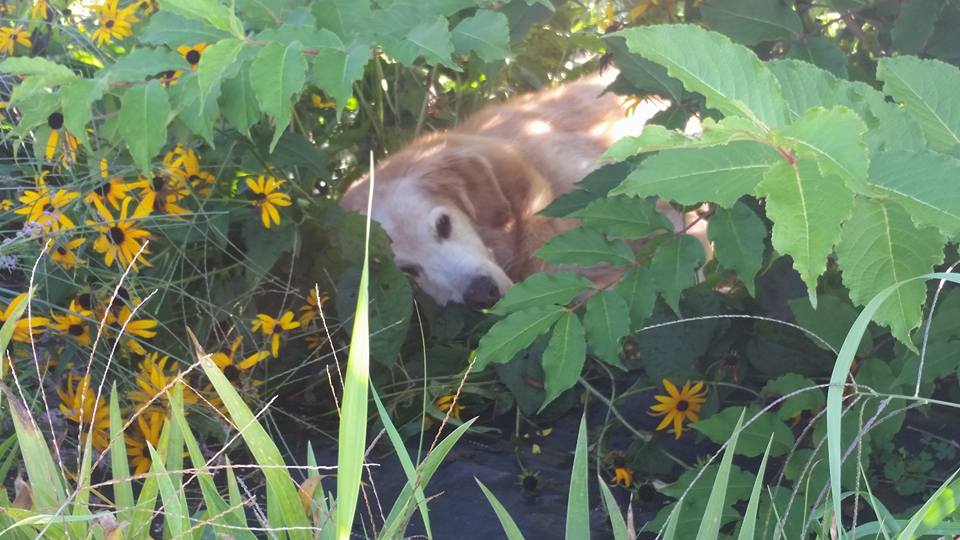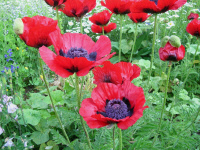…grayi Gray’s sedge Cercis canadensis Redbud Chasmanthium latifolium Northern sea oats Clematis – all Cornus alternifolia Pagoda dogwood Dicentra – all- Bleeding heart Echinacea purpurea Purple coneflower Eryngium yuccifolium Rattlesnake…
More »Search Results for: bleeding heart vine
-
Clematis fremontii Fremont’s leatherflower Z 4-7
OUT OF STOCK Purple to white nodding bells with petal tips flipped up on this short perennial – not a vine...
OUT OF STOCK
Purple to white nodding bells with petal tips flipped up on this short perennial – not a vine
Size: 12-18” x 12”
Care: sun to part shade in moist to moist well-drained soil
Native: Missouri, Kansas & Nebraska1st collected by John C. Fremont (1813-1890) celebrated American explorer, instigator of the “Bear Revolt” that made California independent from Mexico. Governor, then senator of California, owner of California gold mine, abolitionist (“free soil” Republican), leader of soldiers who massacred Native Americans, 1st candidate for president on the Republican ticket and Civil War general fired by Lincoln for freeing the slaves of Missouri. After accumulating fabulous wealth (gold mine) and spending it all, he died in poverty in New York. I call him the most interesting American you never heard of.
-
Hydrangea petiolaris syn. Hydrangea anomala petiolaris Climbing hydrangea Z 4-8
ARCHIVED Note: This is a plant not currently for sale. This is an archive page preserved for informational use. Big white lacecap flowers blanket this climbing vine in early summer....
ARCHIVED
Note: This is a plant not currently for sale. This is an archive page preserved for informational use.
Big white lacecap flowers blanket this climbing vine in early summer.
Size: 40’ x 5-10’
Care: sun or shade in moist to moist well-drained soil
Native: Japan & Korea
Awards: Royal Horticultural Society Award of Garden MeritCollected by German physician and botanist Philipp Franz von Siebold in Japan during his residency on Nagaski working for the Dutch trading post there, 1823-1829. He introduced more then 2000 Japanese plants to Europe. 1st described in Flora Japonica 1839
-
Clematis ‘Madame Julia Correvon,’ Z 4-9
Rich-red petal-like tepals 3-4” across bloom from June to September, encircling yellow stamens, on this vigorous, climbing vine...
Rich-red petal-like tepals 3-4” across bloom from June to September, encircling yellow stamens, on this vigorous, climbing vine
Size: 12’ x 3-6’
Care: Sun to part shade in moist, well-drained soil. Cut back in early spring about 1’ above the soil level and just above a a pair of buds.
Wildlife Value: deer and rabbit resistant. Walnut tolerant. Attracts bees and butterflies.
Awards: Royal Horticultural Society Award of Garden MeritFrancisque Morel, Clematis breeder in Lyon France, grew this Clematis in 1900 from a cross of Clematis viticella ‘Rubra grandiflora’ and Clematis ‘Ville de Lyon,’ Named for the wife of the award-winning Geneva Switzerland nurseryman and author specializing in alpine plants, Henri Correvon (1855-1935). Nurseries at at 2 Chemin Dancet, 2 Plainpalais and Chêne-Bourg. Obituary https://www.nature.com/articles/144183b0.
-
Clematis virginiana Virgin’s bower, Devil’s darning needles Z 4-8
July-September star-like white blossoms cover this vine – good for clambering up small trees.
July-September star-like white blossoms cover this vine – good for clambering up small trees.
Size: 12-20’ x 4’
Care: Sun to shade moist well-drained soil. Flowers on new stems so cut back in late winter or early spring to 6-8” above the ground.
Native: Nova Scotia to Georgia and as far west as Kansas, Wisconsin nativeThe genus Clematis was named by Dioscordes, physician in Nero’s army, from “klema” meaning climbing plant. One of 1st No. American plants sent to Europe – grew in Tradescant the Elder’s South Lambeth nursery in 1634. Grown by Jefferson at Monticello in 1807. Described by Breck in his 1851 book The Flower Garden: “The flowers are white borne upon cymes, and make a handsome appearance.” Cherokee mixed this plant with milkweed to remedy backaches. A root extract cured stomach aches, nervous conditions and kidney ailments. For the Iroquois powdered root fixed venereal disease sores and an extract of the stem brought on strange dreams. Pressed specimen in Emily Dickinson’s herbarium.
-
Emily Dickinson Garden for sun
...or purple 3 Campanula rotundifolia – Harebell 9-12” x 8” blue 1 Clematis virginiana – Virgin’s bower (vine) 12-20’ x 4’ white 3 Geranium pratense – Meadow Cranesbill 24-36” x...
ARCHIVED
Note: This collection is not currently for sale. This is an archive page preserved for informational use.
Emily Dickinson Garden for Sun Size : Height x width* Bloom color
1 Alcea rosea – Hollyhock 2-3’ x 2’ varies
3 Aquilegia canadensis – Canada columbine 24-36”x 12” red
1 Aster novae angliae – New England aster 3-4’ x 24” pink or purple
3 Campanula rotundifolia – Harebell 9-12” x 8” blue
1 Clematis virginiana – Virgin’s bower (vine) 12-20’ x 4’ white
3 Geranium pratense – Meadow Cranesbill 24-36” x 24” bluish-violet
1 Iris siberica – Siberian iris 3-4’ x 12” purple
3 Lilium lancifoliuim – Tiger lily 3-4’ x 12” orange
1 Peony ‘Sarah Bernhardt’ 36” x 36” pink
3 Zizia aurea – Golden alexander 30″ x 24″ yellowAll plants are perennials except the Hollyhock which is a reseeding biennial.
If planted together in one garden these make a 30 square foot garden. **Most of these plants get wider over time by spreading roots or by self-seeding .
-
Aristolochia durior syn. A. macrophylla, A sipho Dutchman’s pipe, Birthwort Z 4-8
OUT OF STOCK Yellow, mottled brown flowers like Meerschaum pipes in May – June, mostly grown for heart-shaped leaves on this vigorous climber (climbs by twining). Perfect for creating a...
OUT OF STOCK
Yellow, mottled brown flowers like Meerschaum pipes in May – June, mostly grown for heart-shaped leaves on this vigorous climber (climbs by twining). Perfect for creating a screen on pergolas, arbors and fences.
Size: 20-30’ x 2’ at ground, 20’ on top.
Care: sun to shade (one of few vines for shade) in moist well-drained to moist soil. Prune to encourage branching.
Native: Maine to Georgia, west to KS.
Wildlife Value: host Pipevine swallowtail butterflyAristolochia is Greek for easing childbirth. Cherokee applied decoction of root for swollen legs & feet. Collected by Colonial nurseryman John Bartram and sent to England in 1763. Sold in America’s 1st plant catalog, Bartram’s Broadside, 1783. In Colonial and Victorian gardens, popular vine to create privacy and shade
5 Favorite Perennials for the Dog Days of Summer
Spring is over. Peonies, Anemones, Bleeding hearts gone, done, sayonara until next spring. All’s not lost. Many flowers can color your garden in the coming dog days. Here are some…
More »About Us
…“For sale by Owner,” ninety-three year old widow Anne Patterson was moving 2000 miles to live with her daughter. She beamed as she showed me the Fern-leaved bleeding hearts under…
More »-
Papaver bracteatum Great scarlet poppy Z 5-8
Available for purchase in Spring only Glossy fire engine red petals with black heart in June. D.M. Ferry Catalog, 1876: ”great beauty and magnificent.”...
Available for purchase in Spring only
Glossy fire engine red petals with black heart in June. D.M. Ferry Catalog, 1876: ”great beauty and magnificent.”
Size: 3-4’ x 3’
Care: sun in well-drained soil. Foliage dies back in summer & reemerges in the cool autumn. Drought tolerant and deer resistant.
Native: Siberia & Northern IranPapaver bracteatum was introduced to European gardens in 1817 from its native Siberia. Poppies have been grown since at least the time when Homer wrote the Illiad, in which he used the poppy’s hanging bud as a metaphor for a dying soldier. During World War I, Canadian soldier John McCrae again united the poppy with dying soldiers. He wrote “In Flanders’ Field.”

